Rocket Fuel Saga - The Other Side

When discussing the article “The Saga of Rocket Fuels” , a rather painful question was raised about the safety of liquid rocket fuels, as well as products of their combustion, and a little about refueling PH.
Definitely I am not an expert in this field, but “for the ecology” is insulting.
The article ends with a clipping from the publication "The fee for access to outer space . "
Legend (not all are used in this article, Greek letters are difficult to write, so the screenshot)
Indices and abbreviations (not all are used in this article):
а – активный
без — безопасный
вх – входной
взр – взрыв
вых – выходной
г – горючее
дв – двигатель
з – задержка
ж – жидкость
к — камера
кип – кипение
кр – критический
л – летный
м – модельный
н – натурный
max – максимальный
min – минимальный
о – окислитель
т — топливо
АК – азотная кислота
АТ – азотный тетроксид
АЭС – атомная электростанция
ГГ – газогенератор
ДИ, ЗДИ, КВИ и КТИ – доводочные, завершающие доводочные, контрольно-выборочные и контрольно-технологические испытания;
ДУ – двигательная установка
ЖРД – жидкостный ракетный двигатель
ИК – испытательный комплекс
КА – космический аппарат
КВРБ – кислородно-водородный разгонный блок
КК – космический корабль
КПД – коэффициент полезного действия
КРТ – компоненты ракетного топлива
КС – камера сгорания
ЛА – летательный аппарат
МТКС – многоразовая транспортно-космическая система
НДМГ – несимметричный диметилгидразин
ОК – орбитальный корабль
ПГСП – пнемогидравлическая система питания
ПДК – предельно-допустимая концентрация
ПУ – поджигающее устройство
РКК – ракетно-космический комплекс
РН – ракета-носитель
САЗ – система аварийной защиты
СД – сигнализатор давления
СК – стартовый комплекс
СНиП – строительные нормы и правила
СПГ – сжиженный природный газ
ТНА – турбонасосный агрегат
ТНТ – тринитротолуол
ТЭ – топливный элемент
ХСИ и ОСИ – холодные и огневые стендовые испытания ДУ
ЭХГ – электрохимический генератор.
без — безопасный
вх – входной
взр – взрыв
вых – выходной
г – горючее
дв – двигатель
з – задержка
ж – жидкость
к — камера
кип – кипение
кр – критический
л – летный
м – модельный
н – натурный
max – максимальный
min – минимальный
о – окислитель
т — топливо
АК – азотная кислота
АТ – азотный тетроксид
АЭС – атомная электростанция
ГГ – газогенератор
ДИ, ЗДИ, КВИ и КТИ – доводочные, завершающие доводочные, контрольно-выборочные и контрольно-технологические испытания;
ДУ – двигательная установка
ЖРД – жидкостный ракетный двигатель
ИК – испытательный комплекс
КА – космический аппарат
КВРБ – кислородно-водородный разгонный блок
КК – космический корабль
КПД – коэффициент полезного действия
КРТ – компоненты ракетного топлива
КС – камера сгорания
ЛА – летательный аппарат
МТКС – многоразовая транспортно-космическая система
НДМГ – несимметричный диметилгидразин
ОК – орбитальный корабль
ПГСП – пнемогидравлическая система питания
ПДК – предельно-допустимая концентрация
ПУ – поджигающее устройство
РКК – ракетно-космический комплекс
РН – ракета-носитель
САЗ – система аварийной защиты
СД – сигнализатор давления
СК – стартовый комплекс
СНиП – строительные нормы и правила
СПГ – сжиженный природный газ
ТНА – турбонасосный агрегат
ТНТ – тринитротолуол
ТЭ – топливный элемент
ХСИ и ОСИ – холодные и огневые стендовые испытания ДУ
ЭХГ – электрохимический генератор.
The environmental safety of rocket launches, testing and testing of propulsion systems (DU) of aircraft (LA) is mainly determined by the used components of rocket fuel (КРТ). Many КРТ are distinguished by high chemical activity, toxicity, explosion and fire hazard.

Taking into account the toxicity, КРТ are divided into four hazard classes (as the hazard decreases):
- first class: combustible hydrazine series (hydrazine, UDMH and the product Luminale-A);
- the second class: some hydrocarbon combustible (modifications of kerosene and synthetic combustible) and the oxidizer hydrogen peroxide;
- the third class: oxidizers nitrogen tetroxide (AT) and AK-27I (a mixture of HNO3 - 69.8%, N2O4 - 28%, J - 0.12 ... 0.16%);
- the fourth class: hydrocarbon fuel RG-1 (kerosene), ethyl alcohol and aviation gasoline.
Liquid hydrogen, LNG (methane CH4) and liquid oxygen are not toxic , but when operating systems with these MCTs, it is necessary to take into account their fire and explosion hazards (especially hydrogen in mixtures with oxygen and air).
The sanitary and hygienic norms of КРТ are given in the table:
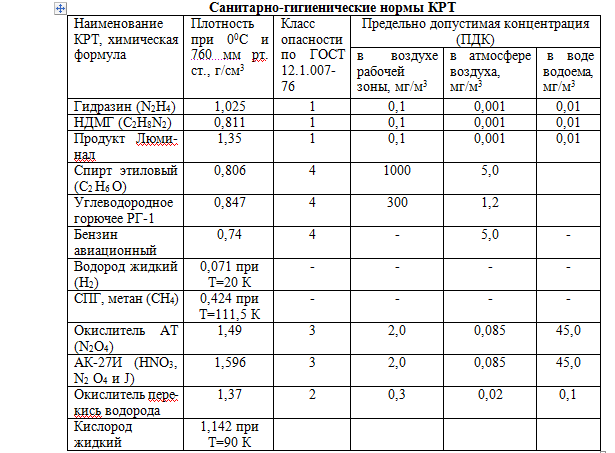
Most of the flammable are explosive and according to GOST 12.1.011 they are classified as Explosive IIA.
Products of complete and partial oxidation of КРТ in engine elements and products of their combustion, as a rule, contain harmful compounds: carbon monoxide, carbon dioxide, nitrogen oxides (NOx), etc.
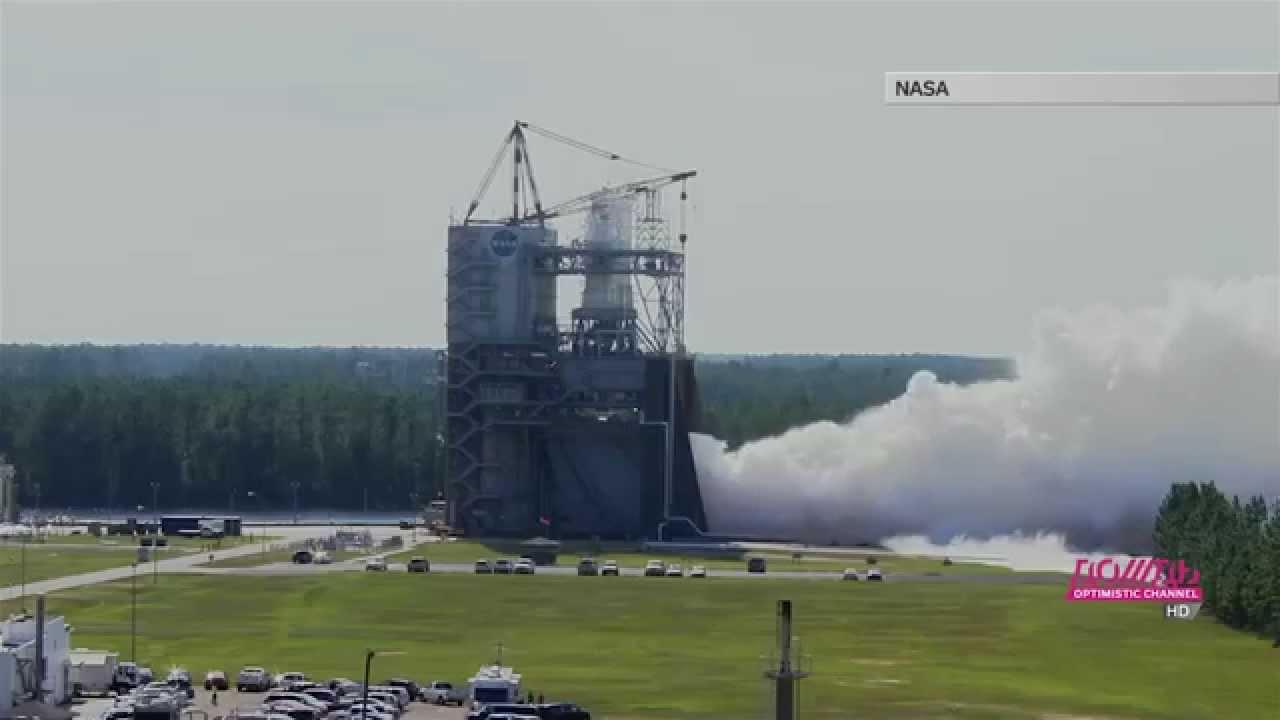
In engines and power installations of rockets, most of the heat supplied to the working fluid (60 ... 70%) is released into the environment with a jet stream of a taxiway or a cooler (water is used in test benches on test benches). Emission of heated exhaust gases into the atmosphere can affect the local microclimate.
A film about the RD-170, its production and testing . NPO "Energomash" two huge exhaust pipes of test benches, accompanying buildings and the neighborhood of Khimki:
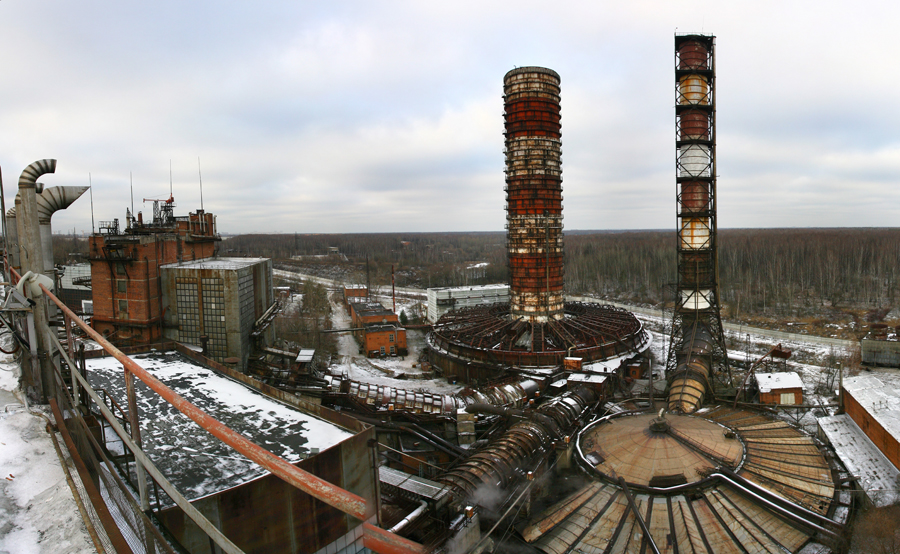

On the other side of the roof: you can see spherical tanks for oxygen, cylindrical - for nitrogen, kerosene tanks a little to the right, did not get into the frame. In Soviet times, the engines for the Proton were tested on these stands. Very close to Moscow.
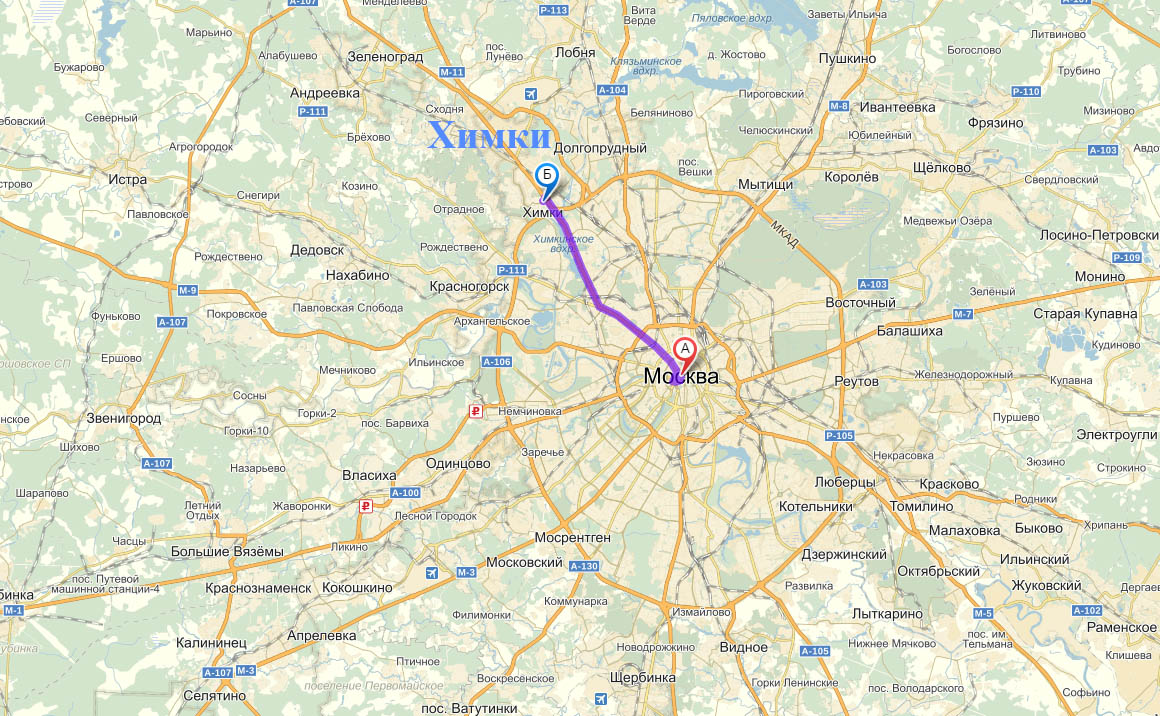
Currently, many "civilian" LREs use hydrocarbon combustible. Their products of complete combustion (water vapor H2O and carbon dioxide CO2) are conventionally not considered to be chemical pollutants of the environment.
All other components are either smoke-generating or toxic substances that have a harmful effect on humans and the environment.
It:
sulfur compounds (S02, S03, etc.); products of incomplete combustion of hydrocarbon fuels - carbon black (C), carbon monoxide (CO), various hydrocarbons, including oxygenated (aldehydes, ketones, etc.), conventionally referred to as CmHn, CmHnOp or simply CH; nitrogen oxides with the general designation NОx; solid (ash) particles formed from mineral impurities in the fuel; compounds of lead, barium and other elements that make up fuel additives.
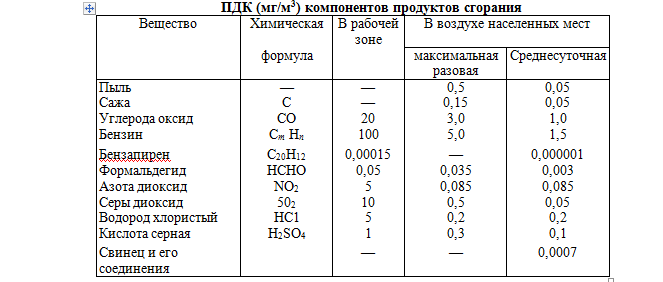
Compared to other types of heat engines, the toxicity of rocket engines has its own characteristics due to the specific conditions of their operation, the fuels used and the level of their mass flow rates, higher temperatures in the reaction zone, effects of combustion of exhaust gases in the atmosphere, and specific engine designs.
The spent stages of launch vehicles (RN), falling to the ground, are destroyed and the guaranteed reserves of stable components of fuel remaining in the tanks pollute and poison the plot of land or reservoir adjacent to the place of fall.
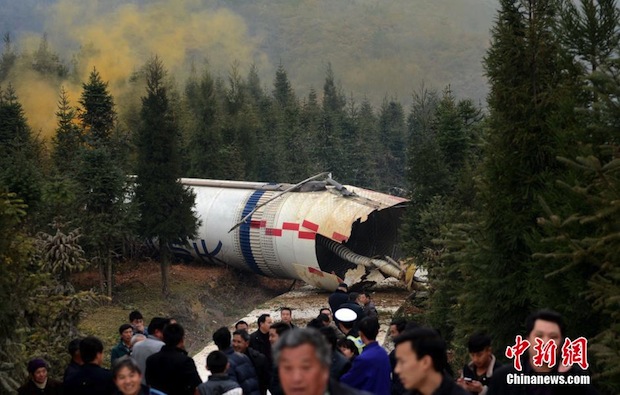
Chinese peasants at the site of the fall of the first stage of the rocket "The Great March": a step on the "stinker" (UDMH + AT). The orange cloud in the picture is an amyl vapor, a very sad thing in terms of toxicity and carcinogenicity. In vain there these people crowd, in vain ...
In order to improve the energy characteristics of the LRE, the fuel components are fed into the combustion chamber at a ratio corresponding to the oxidizer excess coefficient α dv <1.
In addition, methods of thermal protection of the combustion chambers include ways to create near the fire wall of the layer of combustion products with a reduced temperature level by supplying excess fuel. Many modern designs of combustion chambers have curtain belts through which additional fuel is fed into the wall layer. This initially creates a liquid film evenly around the perimeter of the chamber, and then the gas layer of the evaporated fuel. Significantly enriched in fuel, the near-wall layer of the combustion products is maintained until the nozzle exit section.

In the photo: single-component peripheral (fuel) nozzles RD-107/108 to create a wall layer (for cooling the walls of the combustion chamber)
Combustion of exhaust combustion products occurs during turbulent mixing with air. The temperature level developed in this case may in some cases be sufficiently high for the intensive formation of nitrogen oxides NOx from nitrogen and oxygen. Calculations show that non-nitrogen fuels O2G + N2G and O2G + kerosene form, when burned out, 1.7 and 1.4 times more nitric oxide NO, respectively, than the fuel nitrogen tetroxide + NDMG .
The formation of nitric oxide during burnout is particularly intense at low altitudes.
When analyzing the formation of nitric oxide in the exhaust plume, it is still necessary to take into account the presence in technical liquid oxygen of up to 0.5 ... 0.8% by weight of liquid nitrogen.
"The law of transition of quantitative changes into qualitative" (Hegel)and here plays a cruel joke with us, namely the second mass flow of TC: here and now.
Example: the cost of fuel components at the time of launch of the Proton LV is 3800 kg / s, the Space Shuttle is more than 10,000 kg / s and the Saturn-5 PH is 13000 kg / s. Such expenses cause accumulation in the launch area of a large amount of products of combustion, pollution of clouds, acid rain and changes in weather conditions on the territory of 100–200 km2.

NASA has been studying the effects of the Space Shuttle on the environment for a long time, especially since the Kennedy Space Center is located in the reserve .
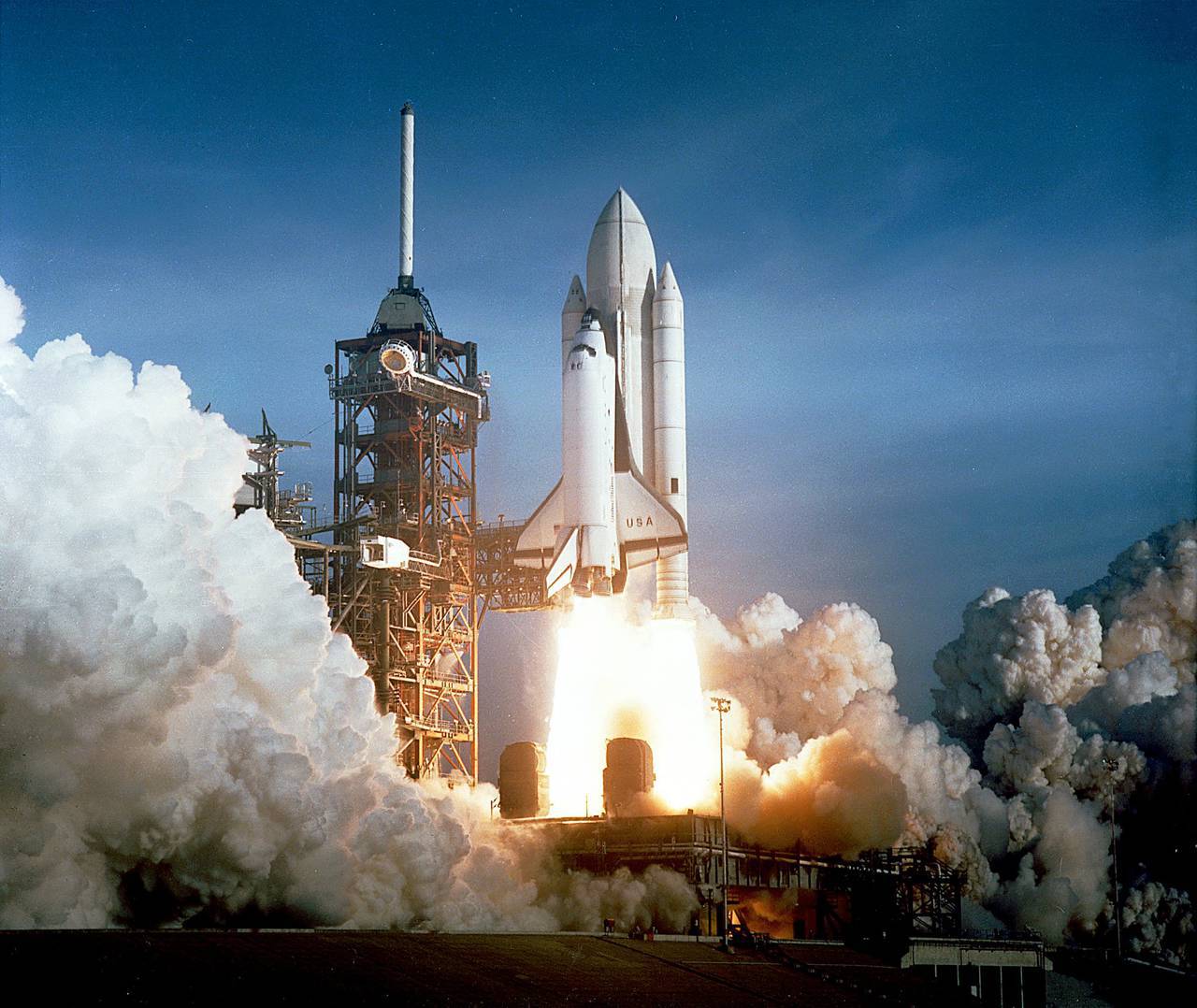
In the process of launch, three sustainer engines of the orbital ship burn liquid hydrogen, and solid propellant accelerators — ammonium perchlorate with aluminum. According to NASA estimates, the ground cloud in the area of the launch pad contains about 65 tons of water, 72 tons of carbon dioxide, 38 tons of aluminum oxide, 35 tons of hydrogen chloride, 4 tons of other chlorine derivatives, 240 kg of carbon monoxide and 2.3 tons of nitrogen . Tons of brothers! Tens of tons.
Here, of course, it plays a role that the “space shuttle” has not only environmental fuel rocket engines, but also the most powerful in the world “partially toxic” solid propellant rocket motors. In general, even that zakoristy kokteylchik obtained at the exit.
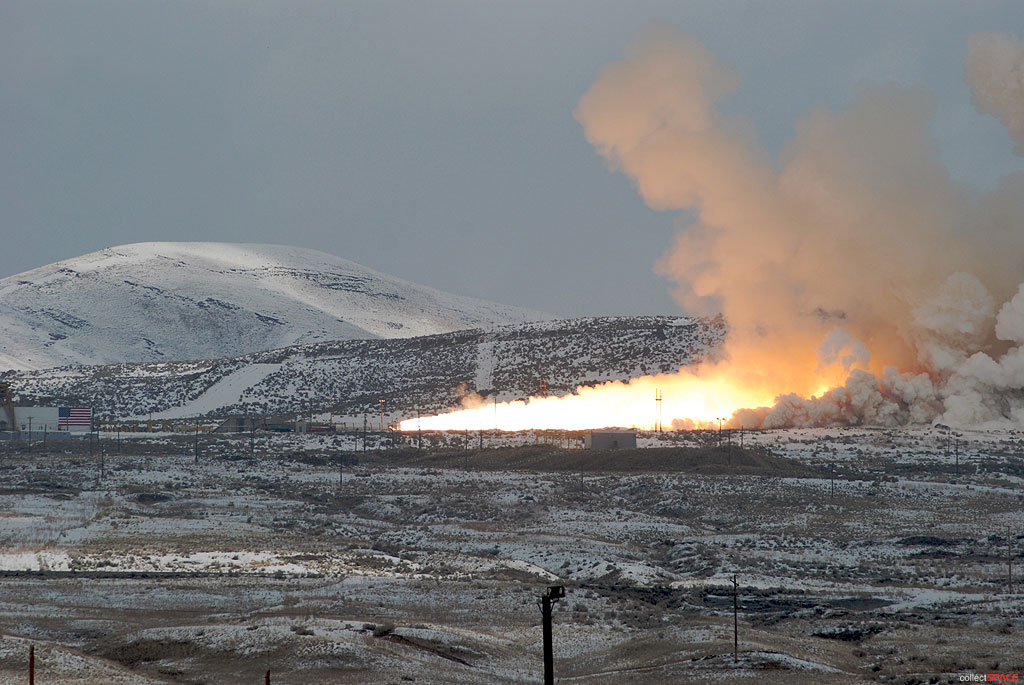
Hydrogen chloride in water is converted to hydrochloric acid and causes major environmental disturbances around the starting complex. Near the launch site there are extensive pools of cooling water in which fish is found. Increased acidity on the surface after the start leads to the death of the fry. Larger juveniles that live deeper survive. Oddly enough, no disease was detected in the birds eating the dead fish. Probably for now. Moreover, the birds adapted to fly for easy prey after each launch. Some species of plants die after starting, but crops of useful plants survive. Under unfavorable wind, the acid falls outside the three-mile zone around the launch complex and destroys the paint on cars. Therefore, NASA issues special covers to owners, whose cars are in a dangerous area on launch day. Aluminum oxide is inert, and although it can cause lung disease, it is believed that its concentration at the time of launch is not dangerous.
Okay, the “Space Shuttle” - at least H2O (H2 + O2) is combined with the oxidation products of NH4ClO4 and Al ... And here is an example for the 5UR21A SAMC S-200V:
1. Marching LRE 5D12: АТ +
НДМГ 2. Boosters РДТТ 5С25 ( 5С28) four pieces of charge of mixed TT 5B28 type RAM-10k
→ Video clip about C 200 launches
→ Combat operation of the technical division of the C200
SIRS invigorating breathing mix in the area of combat and training launches.
Let's go back to the LPRE. On the specifics of solid propellant solid fuel, their ecology and components for them, in another article.
The efficiency of the propulsion system can be assessed onlybased on test results. So, to confirm the lower limit of the probability of failure-free operation (FBG) Rn> 0.99, with a confidence level of 0.95, n = 300 fail-safe tests must be carried out, and for Rn> 0.999 - n = 1000 trouble-free tests.
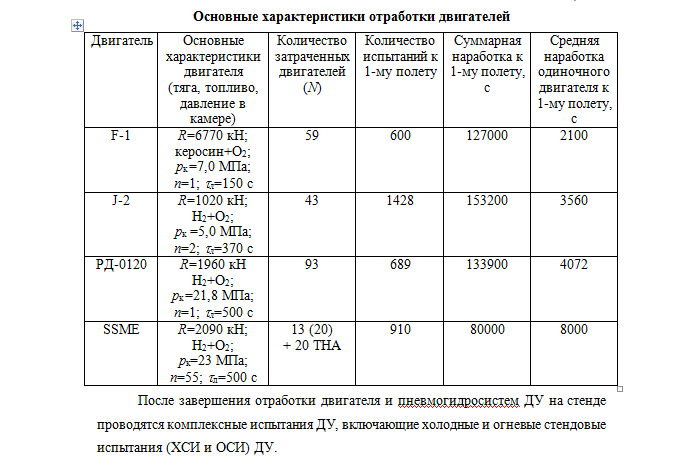
If we consider the LRE, the process of mining is carried out in the following sequence:
- testing of elements, assemblies (pumping units and pump supports, pump, gas generator, combustion chamber, valve, etc.);
- testing systems (THA, THA with GG, GG with KS, etc.);
- tests of the engine simulator;
- engine tests;
- engine tests as part of a remote control;
- flight tests of the aircraft.
In the practice of creating engines, there are 2 known bench finishing methods: sequential (conservative) and parallel (accelerated).
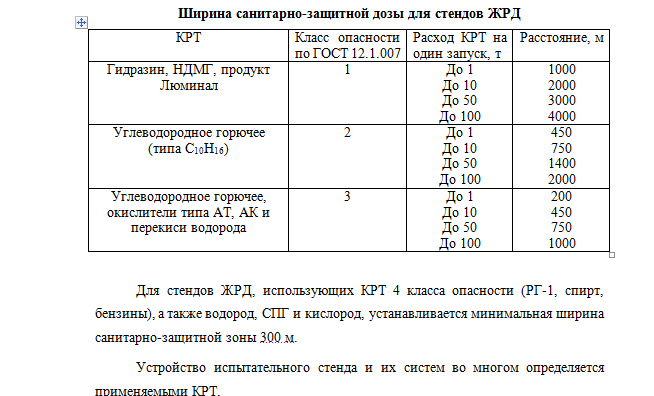
The test bench is a technical device for installing the test object at a predetermined position, creating impacts, retrieving information and managing the test process and test object.
Test benches for various purposes usually consist of two parts connected by communications:
- executive, consisting of the test object and systems that provide the impact of various operational factors;
- command in the form of a control panel and information systems (transformation, analysis and display of information about the parameters of the test object).
Schemes will give understanding more than my verbal constructions:
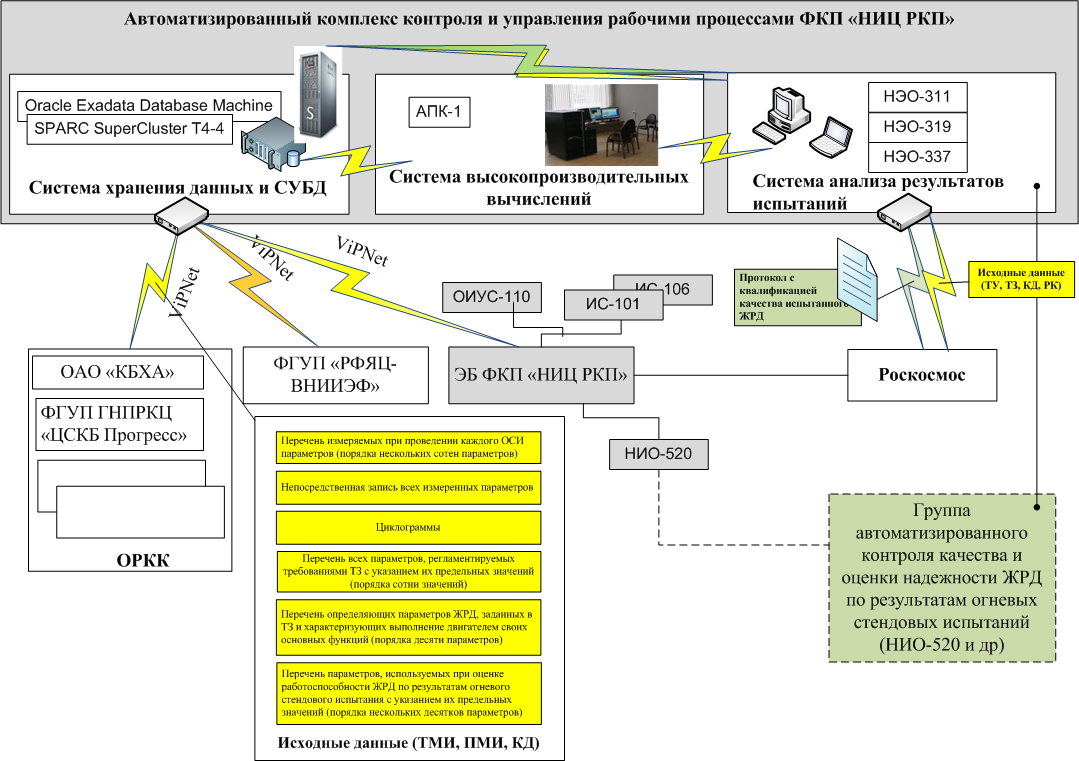
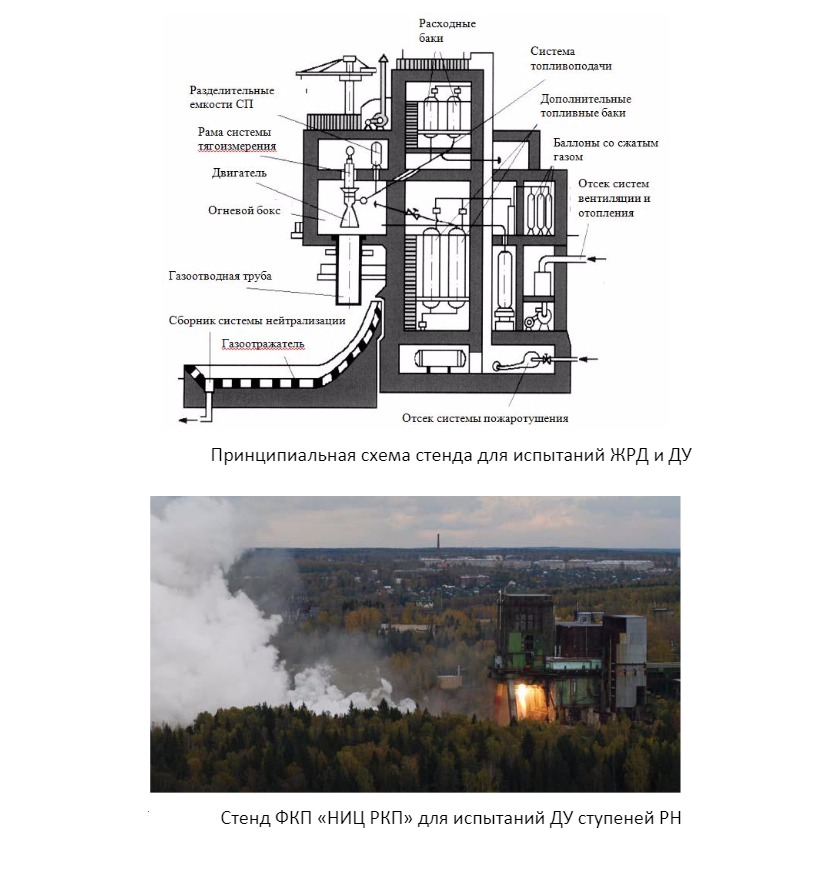
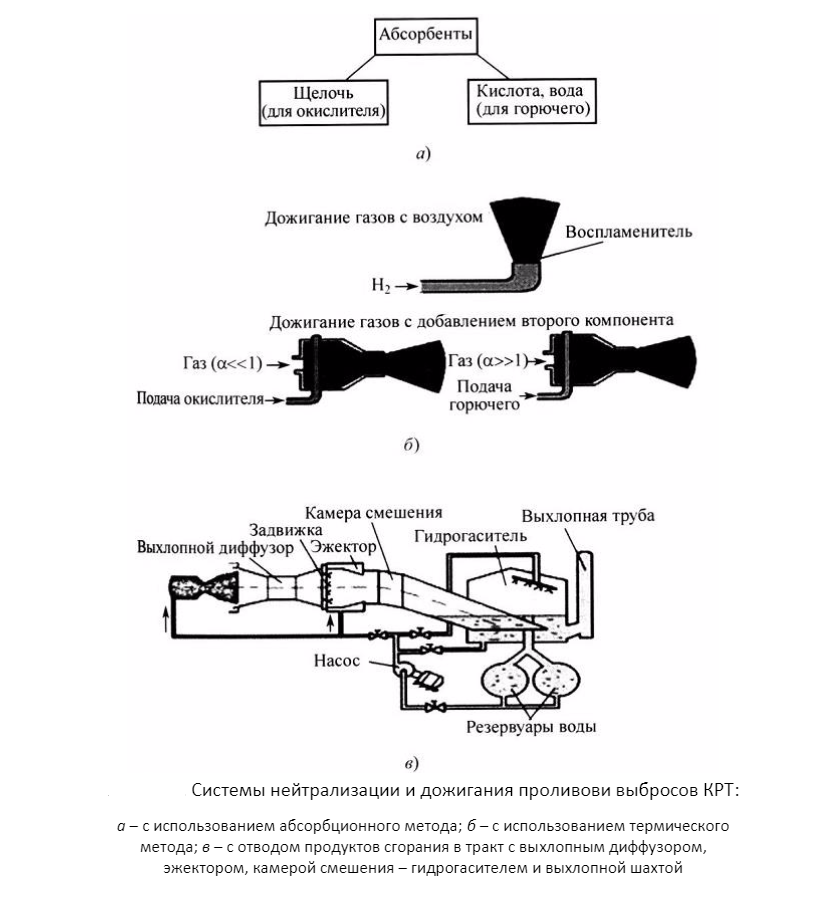
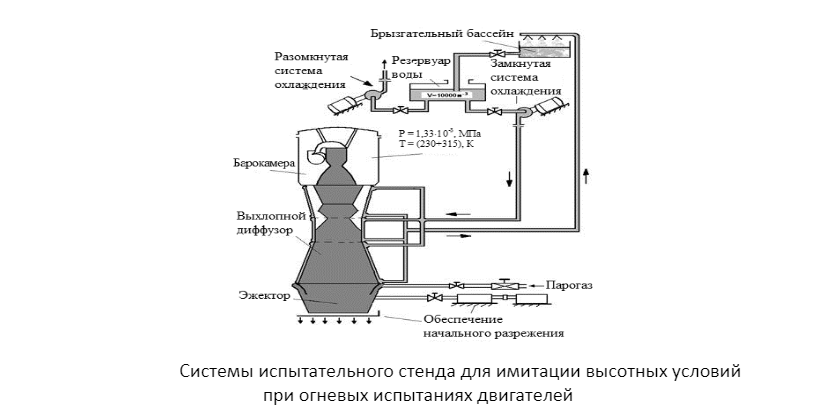
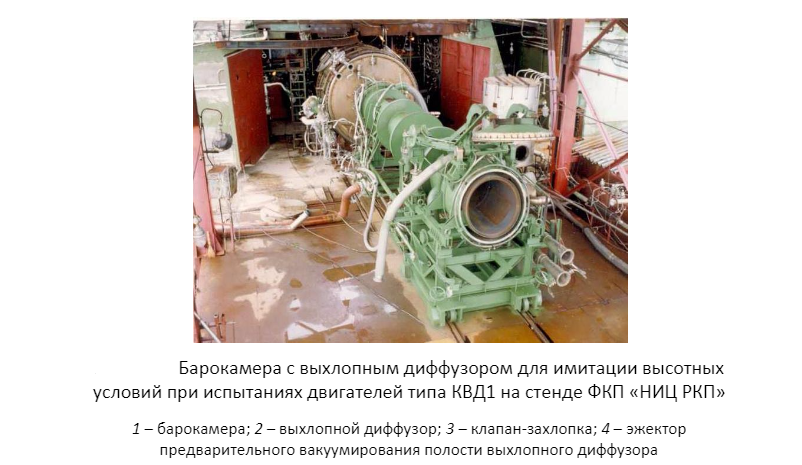
Reference:
testers and those who worked with UDMH / heptyl / were granted in the USSR: 6-hour working day, vacation 36 working days, length of service, retirement at 55, subject to working in hazardous conditions for 12.5 years, free food, preferential trips to the sanatorium and d / o. For medical care, they were attached to the 3rd GU of the Ministry of Health, as well as the enterprises of Sredmash, with obligatory regular medical examination. Mortality in the departments was much higher than the average for the enterprises of the industry, mainly for cancer, although they were not classified as professional.
At present, the Proton carrier rocket using highly toxic components of the UDMH and AT fuels is used for the removal of heavy loads (orbital stations with a mass of up to 20 tons) in the Russian Federation. To reduce the harmful effects of the PH on the environment, the stages and the rocket engines (“Proton-M”) were modernized to significantly reduce component residues in the tanks and supply lines of the remote control.
More for the withdrawal of payloads in Russia are used (or used) relatively cheap conversion missile systems “Dnepr”, “Strela”, “Rokot”, “Cyclone” and “Cosmos-3M”, working on toxic fuels.
There was an idea (I will tell separately about OCD), to transfer these engines from AT + UDMG fuel components to environmentally friendly ones. For example, on oxygen and kerosene. Many have dealt with this issue in KBKhAThe task was far from simple. Together with the KMZ / Krasnoyarsk / more than 10 years, work continues on the transfer of the 3D-37 engine. In fact, it turns out almost a new engine, although there remained an “acidic” scheme and there were no questions about the cooling capacity of the CS. This engine received an index RD-0155 and RKK Makeeva is considering its possible use in the “Air start”.
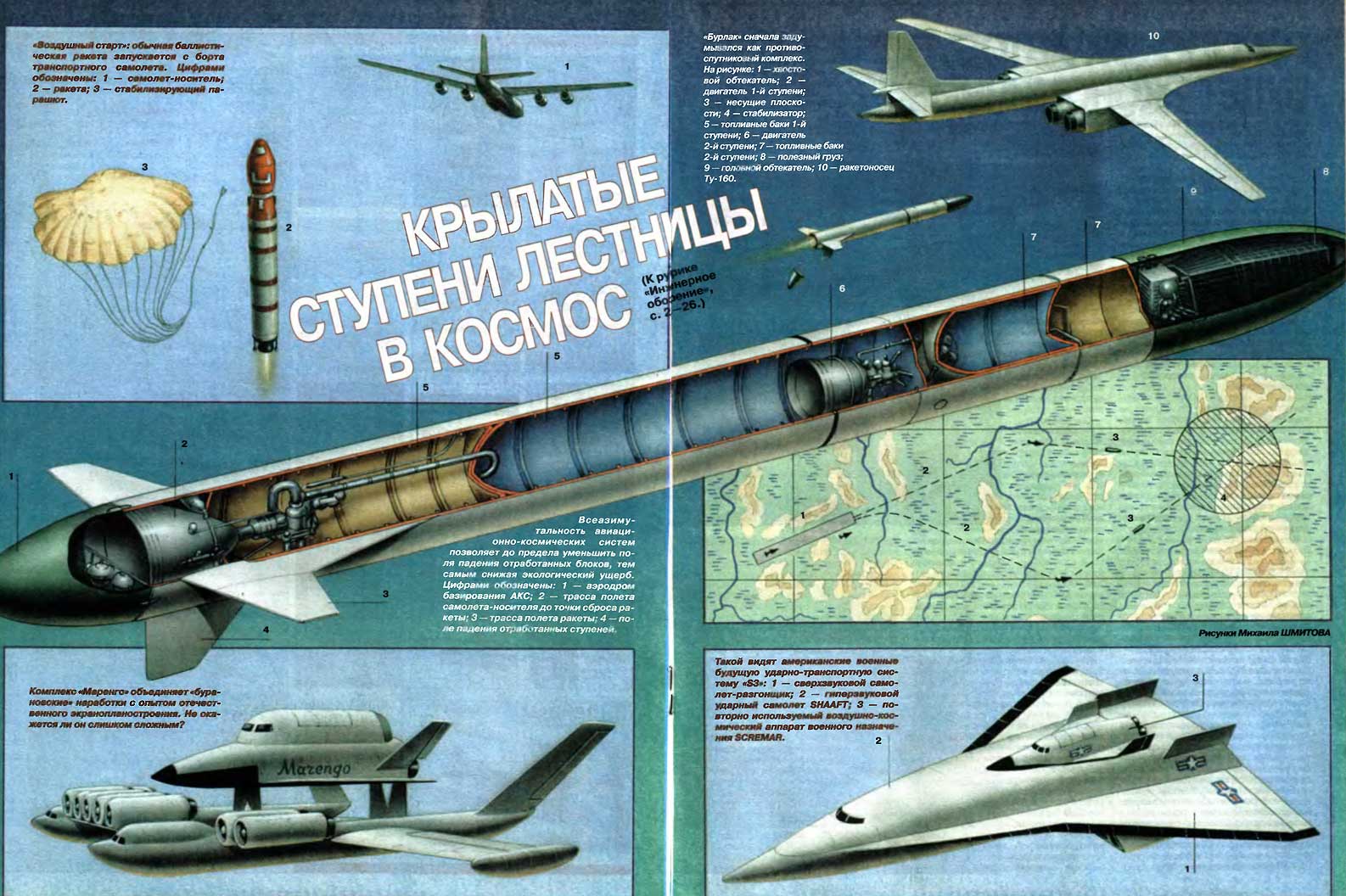
To launch manned spacecraft with astronauts, they are used only (and in our country and in the world, except China), the Soyuz carrier rockets on oxygen-kerosene fuel.
The most ecological TCs are H2 + O2, then kerosene + O2, or HCG + O2.
“Stinkers” are the most toxic and complete the ecological list (fluorine and other exotic things I don’t consider).
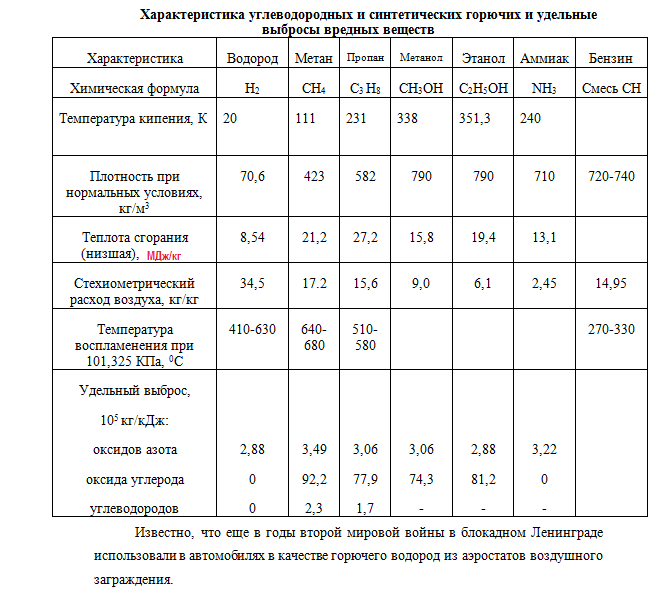
Note: stoichiometric flow rate is given for air, but essentially it does not change much.
Hydrogen and LRE test benches for such fuels have their own “gadgets”. At the initial stage of work with hydrogen, due to its significant explosion and fire hazard in the United States, there was no consensus about the advisability of post-burning all types of hydrogen emissions. Thus, Pratt-Whitney (USA) was of the opinion that burning the entire amount of hydrogen emitted guarantees complete safety tests, therefore, a flame of gaseous propane is supported over all ventilation pipes for hydrogen discharge of test benches.

Douglas-Erkraft (USA) considered it sufficient to release gaseous hydrogen in small quantities through a vertical pipe located at a considerable distance from the test sites, without post-combustion.
In the Russian stands, in the process of preparing and conducting tests, hydrogen emissions are burned at a cost of more than 0.5 kg / s. At lower costs, hydrogen does not burn out, but is removed from the technological systems of the test bench and is discharged into the atmosphere through drainage outlets with nitrogen blowers.
The situation with toxic components of RT (“stinky”) is much worse. As during tests of LRE:
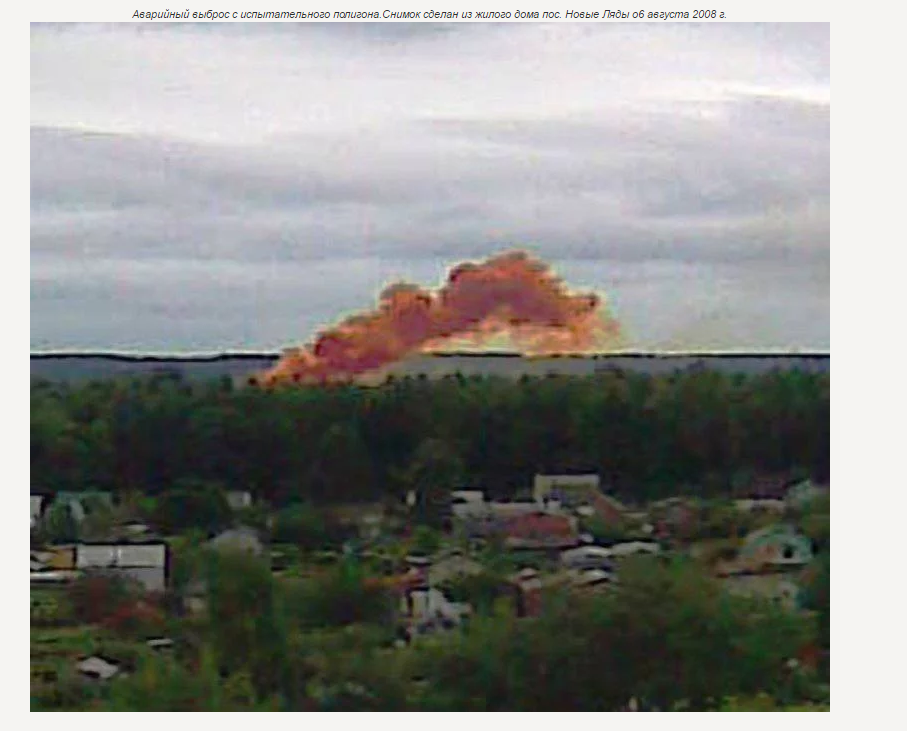
So during launches (both emergency and successful): The
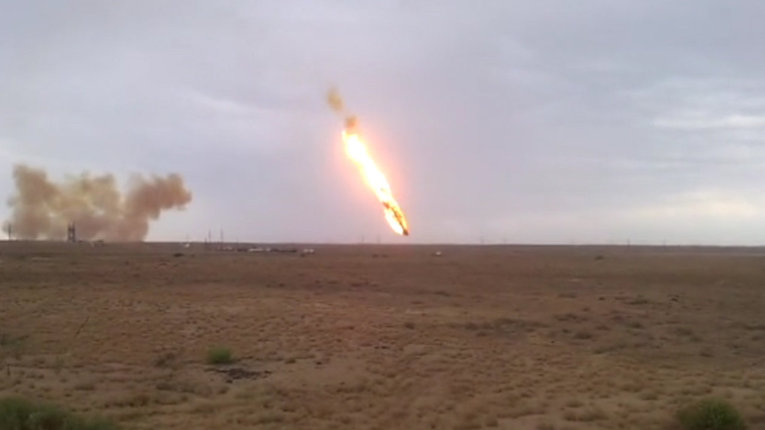
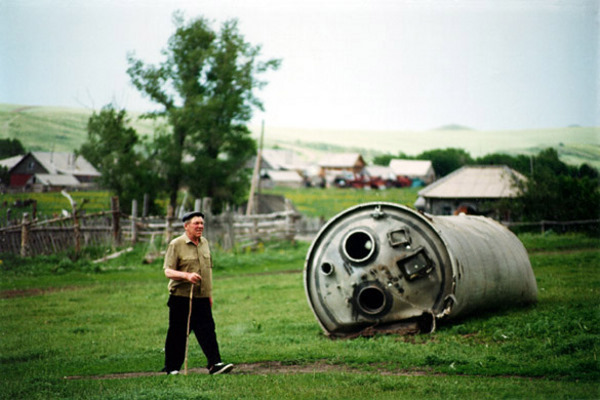
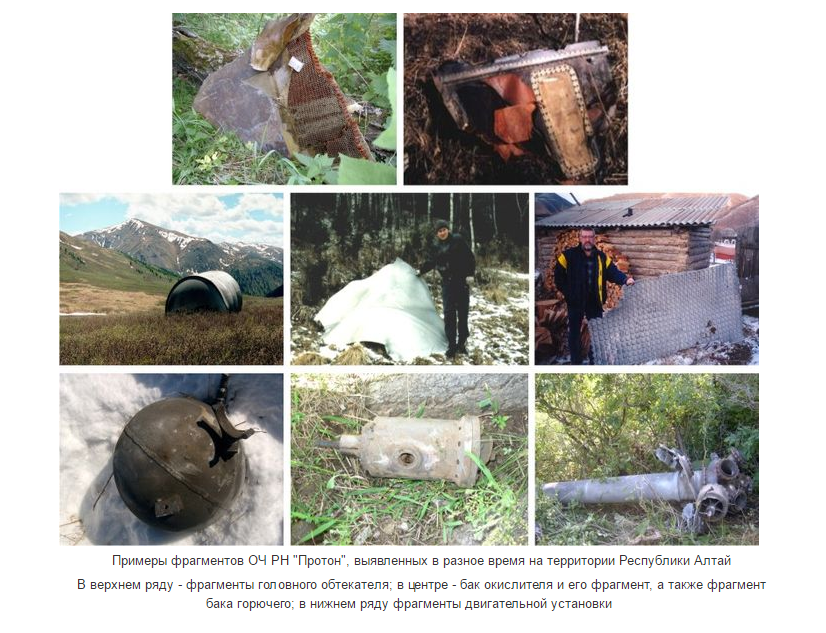
issue of damage to the environment in case of possible accidents at the output area and in the fall of separating parts of the missiles is very important, since these accidents are practically unpredictable.
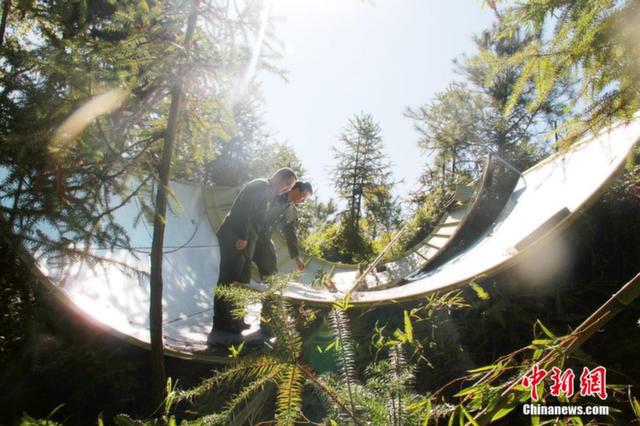
In the western part of the Altai-Sayan region there are six areas (fields) of the fall of the second stages of the launch vehicle launching from the Baikonur cosmodrome. Four of them belonging to the Yu-30 zone (Nos. 306, 307, 309, 310) are located in the extreme western part of the region, on the border of the Altai Territory and the East Kazakhstan Oblast. The falling areas Nos. 326, 327 included in the Yu-32 zone are located in the eastern part of the republic, in close proximity to the lake. Teletskoye.
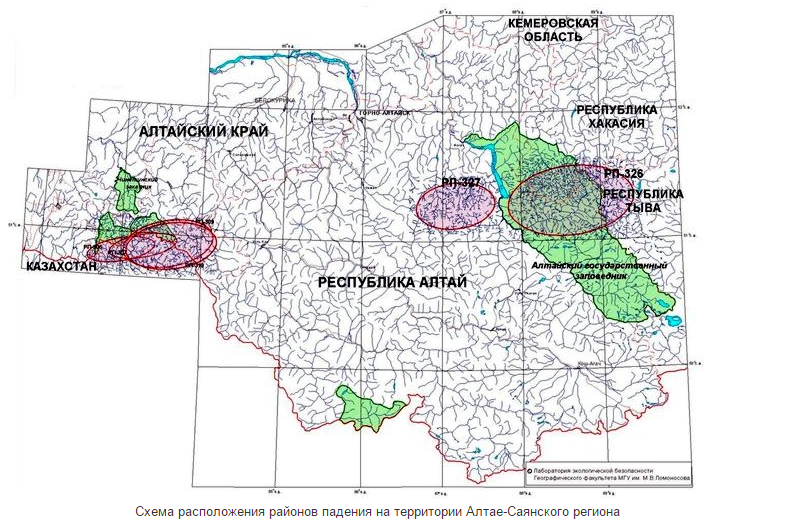
Fall areas No. 306, 307, 309 have been used since the mid-60s (according to official data) for landing the second stages of the Soyuz launch vehicle and its modifications (on hydrocarbon fuels); the rest of the regions - from the beginning of the 70s for the landing of fragments of the second stages of the Proton launch vehicle (hydrazine fuel).
In the case of the use of rockets with environmentally friendly components of fuel, measures to eliminate the consequences in the places of falling of the separating parts are reduced to mechanical methods of collecting the remnants of metal structures.
Special measures should be taken to eliminate the consequences of falling steps, which contain tons of undeveloped UDMH, which penetrates the soil and, being well dissolved in water, can spread over long distances. Nitrogen tetroxide is rapidly dissipated in the atmosphere and is not a determining factor for contamination of the area. According to estimates, it takes at least 40 years for the complete recultivation of land used as a zone of falling steps from UDMH for 10 years. In this case, work should be carried out on the excavation and transportation of a significant amount of soil from the places of fall. Studies in the places of the fall of the first steps of the Proton LV showed that the zone of soil contamination with a fall of one step covers an area of ~ 50 thousand m2 with a surface concentration in the center of 320-1150 mg / kg, which is thousands of times higher than the maximum allowable concentration.
Currently, there are no effective ways to neutralize the contaminated areas with combustible UDMH.
World Health Organization UDMH is listed as a highly hazardous chemical compound. Heptyl is 6 times more toxic than hydrocyanic acid.
Products of heptyl and amyl combustion (oxidation) when testing rocket engines or launching carrier rockets.
In the "wiki" everything is simple and harmless:

in life Km and alpha: the mass ratio of oxidizer / fuel is 1.6: 1 or 2.6: 1 = completely wild excess of oxidizer (example: N2O4: UDMG = 2.6: 1 (260 g and 100 g respectively)):
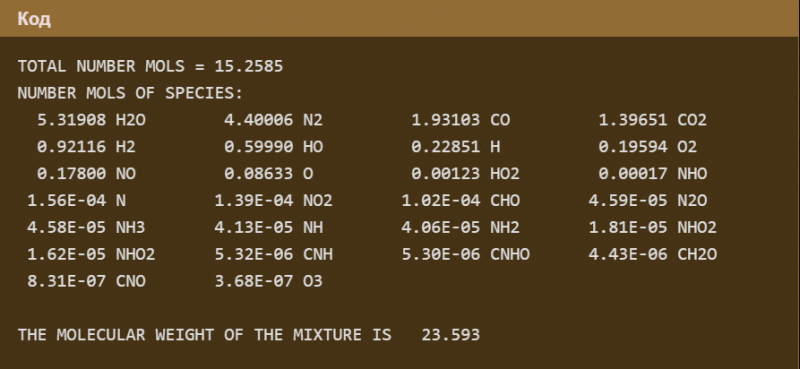
When this cocktail is found with another cocktail — our air + organic matter (pollen) + dust + sulfur oxides + methane + propane +, etc., the results of oxidation look like this:
Nitrosodimethylamine (chemical name: N-methyl-N-nitrosomethanamine). Formed during the oxidation of heptyl amyl. Well soluble in water. Enters into the reaction of oxidation and reduction, with the formation of heptyl, dimethylhydrazine, dimethylamine, ammonia, formaldehyde and other substances. It is a highly toxic substance of the 1st hazard class. Carcinogenic, has cumulative properties. MPC: in the air of the working area - 0.01 mg / m3, that is 10 times more dangerous compared to heptyl, in the atmospheric air of populated areas - 0.0001 mg / m3 (daily average), in the water of ponds-0.01 mg / l.
Tetramethyltetrazene(4,4,4,4-tetramethyl-2-tetrazene) is a product of the decomposition of heptyl. Boundedly soluble in water. Stable in abiotic environment, very stable in water. Decomposes to form dimethylamine and a number of unidentified substances. By toxicity has a 3rd hazard class. MPC: in the atmospheric air of settlements - 0.005 mg / m3, in the water of reservoirs –0.1 mg / l.
Nitrogen dioxide NO2- strong oxidizer, organic compounds ignite in a mixture with it. Under normal conditions, nitrogen dioxide exists in equilibrium with amyl (tetra-nitrogen oxide). Irritating to the pharynx, it may be shortness of breath, swelling of the lungs, respiratory mucous membranes, degeneration and tissue necrosis in the liver, kidneys, human brain. PDK: in the air of the working area-2 mg / m3, in the atmospheric air in populated places-0.085 mg / m3 (maximum one-time) and 0.04 mg / m3 (daily average), hazard class – 2.
Carbon monoxide (carbon monoxide)-product of incomplete combustion of organic (carbon-containing) fuels. Carbon monoxide can last for a long time (up to 2 months) in the air without change. Carbon monoxide poison. Binds blood hemoglobin to carboxyhemoglobin, impairing the ability to transport oxygen to human organs and tissues. MPC: in the atmospheric air of populated areas - 5.0 mg / m3 (maximum one-time) and 3.0 mg / m3 (daily average). In the presence of carbon monoxide and nitrogen compounds in the air at the same time, the toxic effect of carbon monoxide on people is enhanced.
Hydrocyanic acid (hydrogen cyanide) -it is a strong poison. Prussic acid is extremely toxic. It is absorbed by intact skin, has a general toxic effect: headache, nausea, vomiting, respiratory distress, asphyxia, convulsions, death can occur. In acute poisoning, hydrocyanic acid causes rapid asphyxiation, increased pressure, oxygen starvation of tissues. At low concentrations, there is a feeling of scratching in the throat, burning bitter taste in the mouth, drooling, damage to the conjunctiva of the eyes, muscle weakness, staggering, difficulty speaking, dizziness, acute headache, nausea, vomiting, urge to have a bowel movement, rush of blood to the head, increased heartbeat and other symptoms.
Formaldehyde (formic aldehyde)-toxin. Formaldehyde has a strong odor, it is very irritating to the mucous membranes of the eyes and nasopharynx even at low concentrations. It has a general toxic effect (damage to the central nervous system, organs of vision, liver, kidneys). It has an irritating, allergenic, carcinogenic, mutagenic effect. Maximum allowable concentration in atmospheric air: average daily - 0.012 mg / m3, maximum one-time - 0.035 mg / m3.
Intensive rocket and space activity in Russia in recent years has given rise to a huge number of problems: environmental pollution by separating parts of launch vehicles, toxic components of rocket fuel (heptyl and its derivatives, nitrogen tetroxide, etc.)
The whole history of relations between our country and heptyl is a chemical war, only chemical war is not just an undeclared one, but simply unidentified by us.
Briefly about the military use of heptyl:
There were missile defense system missile systems, sea submarine ballistic missiles (SLBMs), space missiles, of course, air defense missiles, as well as operational-tactical missiles (medium-range).
In total it turns out at least six directions. The Army and Navy left a “heptyl” mark in Vladivostok and the Far East, Severodvinsk, the Kirov region and a number of neighborhoods, Plesetsk, Kapustin Yar, Baikonur, Perm, Bashkiria, etc.
We must not forget that the missiles were transported, repaired, reloaded, etc., and all this on land, near industrial facilities, where this heptyl was produced.
About the accident with these highly toxic components and about informing the civil authorities, civil defense (EMERCOM) and the public - who knows, he will tell more.
It is necessary to remember the places of production and testing of engines are not in the desert: Voronezh, Moscow (Tushino), the plant "Nefteorgsintez" in Salavat (Bashkiria), etc.
Several dozen ICBM R-36M, UTTH / R-36M2 are on duty in the Russian Federation

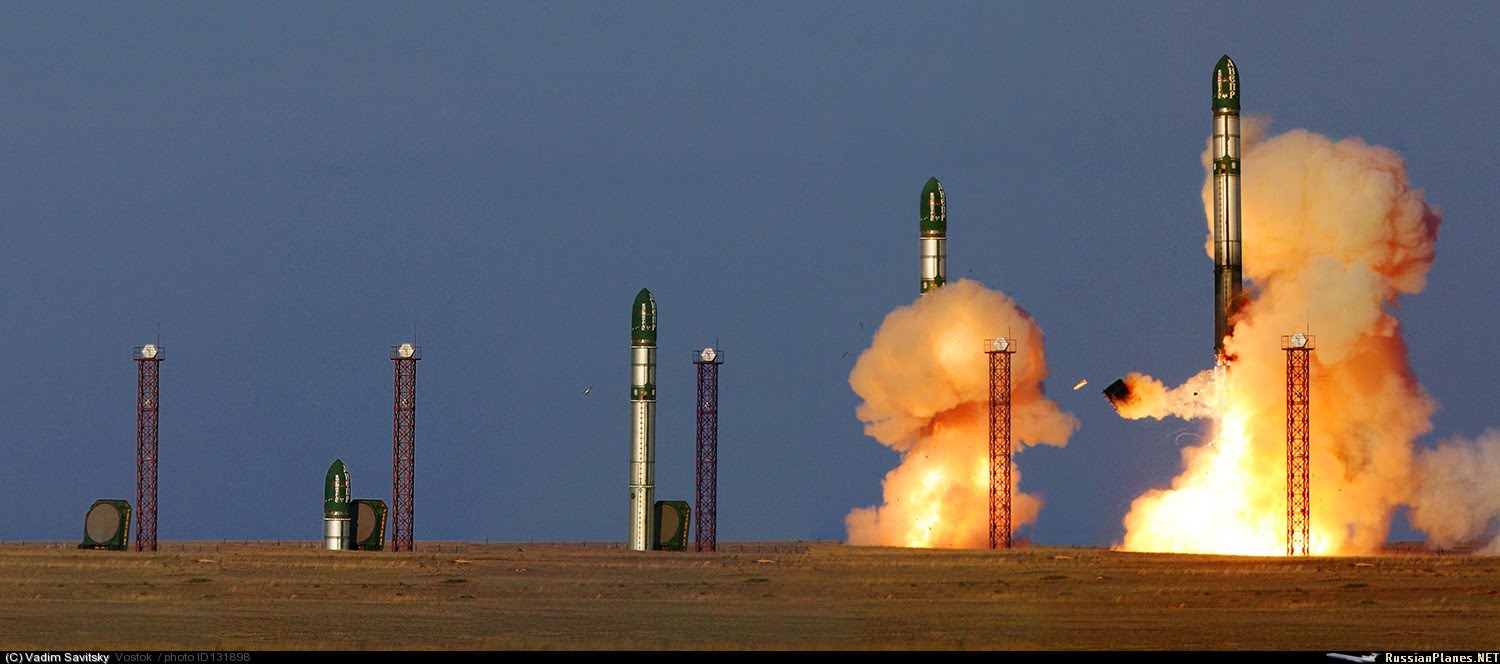
and UR-100N UTTH with heptyl dressing.
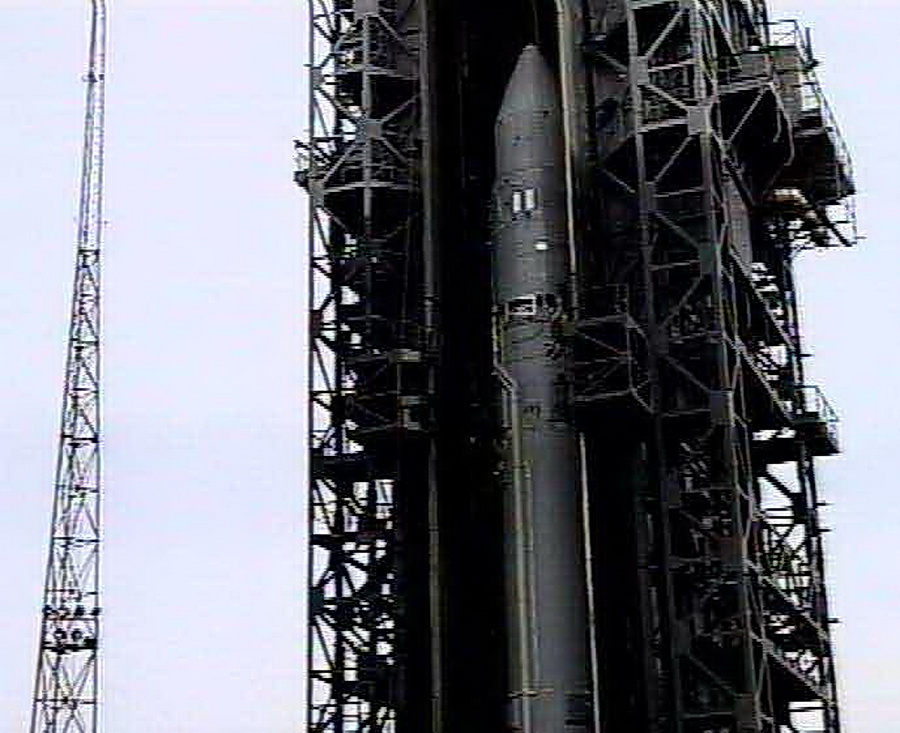
In the photo: “Rokot” (14A05), designed at the Khrunichev Center based on the RS-18 ICBM (UR-100N UTTH)
Unfortunately, the coordinates of the activities of the air defense forces operating with the C-75, C-100, C-200 missiles are more difficult.
Once every few years, heptyl has been drained off and will be drained from missiles, transported in refrigeration across the country for processing, brought back, refilled, and so on. Not to avoid rail and road accidents (it happened and such). The army will work with heptyl, and all will suffer, not only the rocket men themselves.
Another problem is our low average annual temperatures. Americans are easier.
According to experts of the World Health Organization, the period of neutralization of heptyl, which is a toxic substance of hazard class I, at our latitudes is: in soil - more than 20 years, in water bodies - 2-3 years, in vegetation - 15-20 years.
And if the country's defense capability is sacred and in the 50s to the 90s we just had to put up with it (either heptyl or one of the 10 programs of the US attack on the USSR), then is there any sense and logic using launch vehicles? on UDMH and AT for launching foreign spacecraft, receive money for the service and at the same time persecute their own people or the people of friendly Kazakhstan?
Again "Swan, cancer and pike"?
On the one hand: the lack of costs for the disposal of combat LVs (ICBMs, SLBMs, missiles, and OTR), and even profit and savings on the cost of launching into orbit;
On the other hand: the harmful effects on the environment, the population in the start and fall zone, the spent stages of conversion PH;
And on the third hand: now it cannot do without a PH on high-boiling components of the Russian Federation.
GCI R-36M2 / PC-20V Voyevoda (SS-18 mod.5-6 SATAN) for some political aspects (PO Southern Mashinostroitelny Zavod (Dnepropetrovsk)), and simply cannot be extended for temporary degradation.
Perspective heavy intercontinental ballistic missile RS-28 / OCR Sarmat, missile 15A28 - SS-X-30 (draft) will be on high-boiling toxic components.
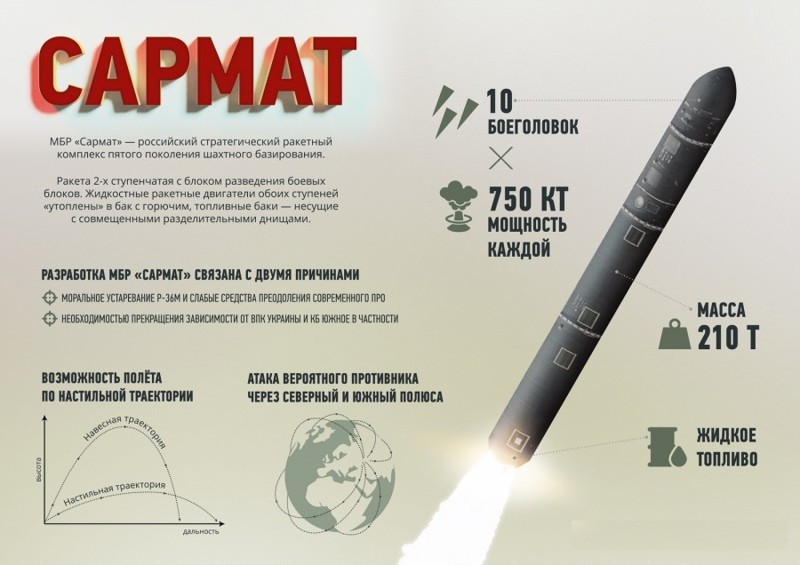
We are lagging behind somewhat in the RDTT and especially in the SLBM:
Chronicle of Torment of the Bulava until 2010

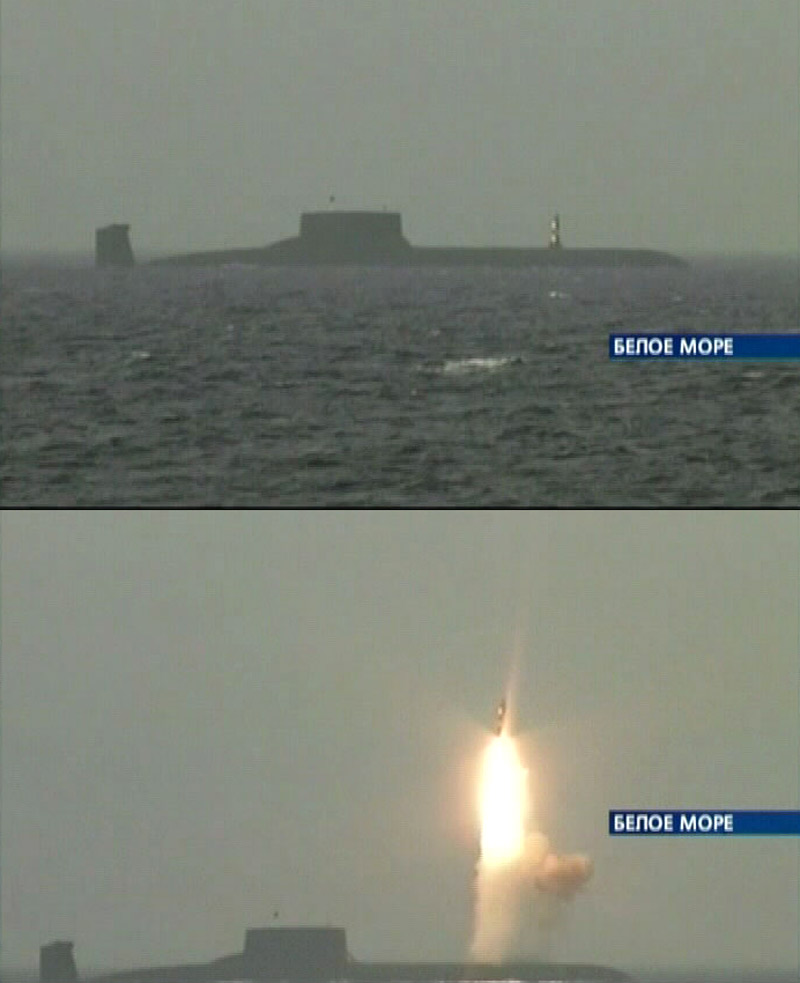
Therefore, the SSRB will use the best in the world (in terms of energy perfection, and generally masterpiece) SLBM R-29RMU2.1 / OCR Liner: on AT + UDMG.
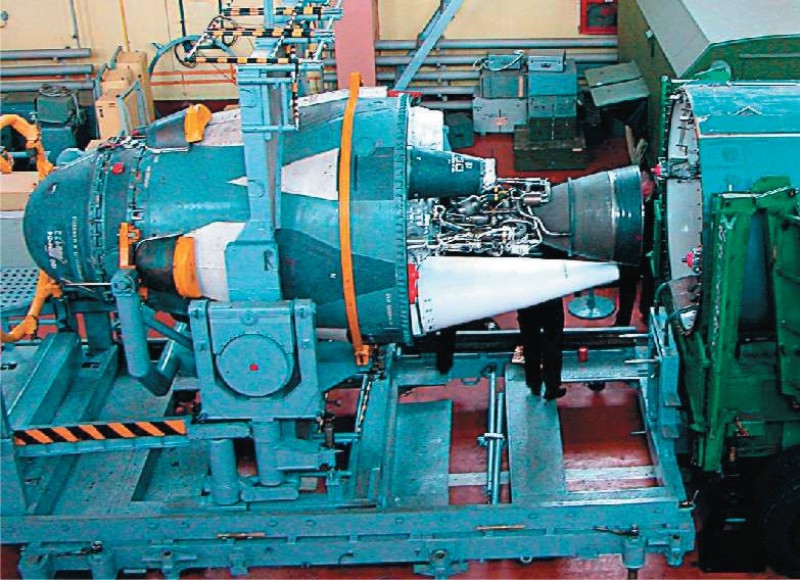
Yes, it can be argued that ampulization has been used in the Strategic Missile Forces and the Navy for a long time and many problems have been solved: storage, operation, personnel security and combat crews.
But using conversion ICBMs for commercial launches is “again the same rake.”
Old (expired guaranteed storage) ICBMs, SLBMs, TRs and OTRs cannot be stored forever, either.
Where is this consensus and how to catch it, I do not know for sure.

Briefly: filling systems for launch complexes of PH using toxic components
At the UK for the Proton launch vehicle, the safety of operations during the preparation and conduct of the launch of the rocket and the maintenance personnel when performing operations with sources of increased danger was achieved by using remote control and maximally automating the processes of preparing and conducting the launch of the launch vehicle, as well as operations carried out on the rocket and technological equipment of the IC in case of cancellation of the launch of the rocket and its evacuation from the SC. A design feature of the starting and filling units and systems of the complex, which provide preparation for the launch and launch, is that the docking of the filling, drainage, electric and pneumatic communications is performed remotely, and the undocking of all communications is carried out automatically. At the launch site there are no cable and cable refueling masts,
The launch complexes of the Kosmos-1 and Kosmos-3M launch vehicles were created on the basis of the R-12 and R-14 systems of ballistic missiles without significant modifications to its connections with the ground equipment.
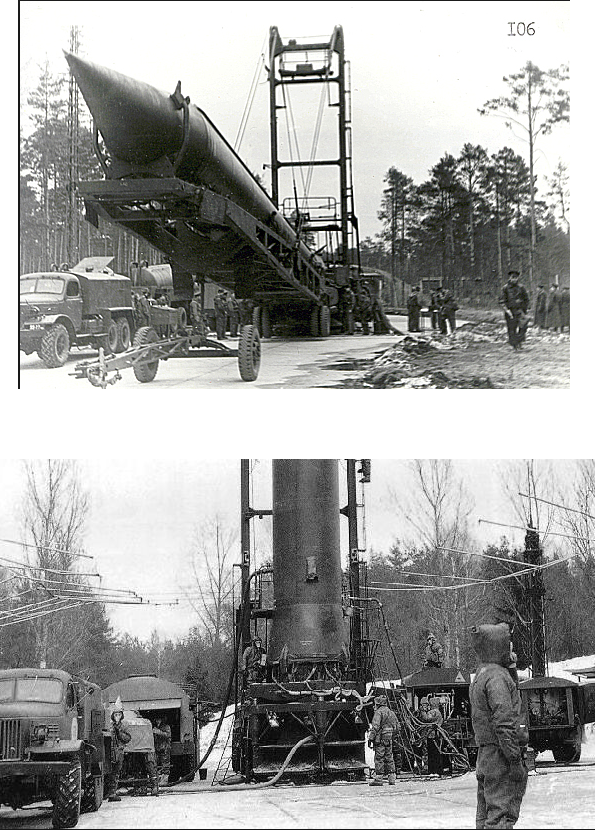
This led to the presence on the launch complex of many manual operations, including on the fuel-charged PH component. Subsequently, many operations were automated and the level of automation of work on the complex Kosmos-3M is already more than 70%.
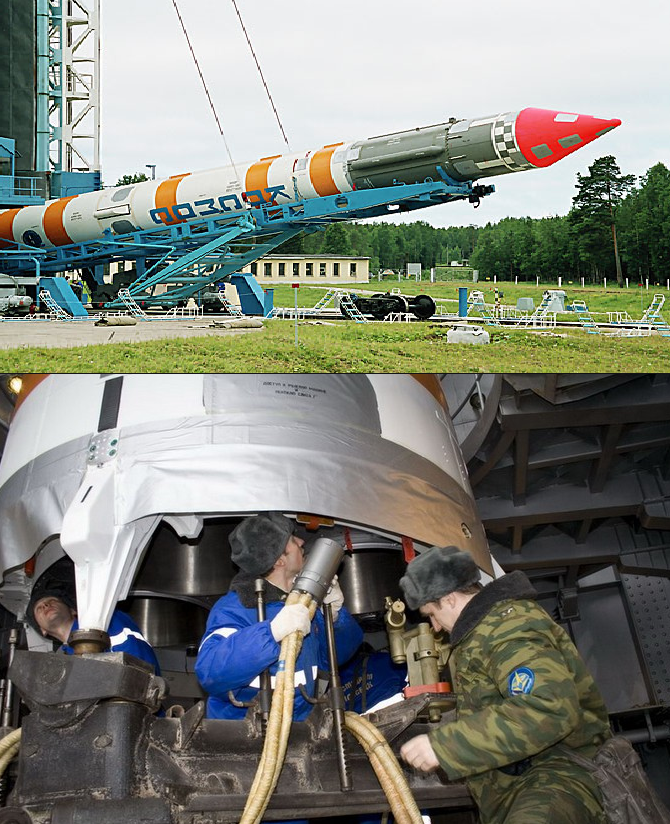
However, some operations, including the reconnection of refueling communications to drain the fuel in case of cancellation of the start, are performed manually. The main systems of the IC are systems for refueling with components of the fuel, compressed gases and a remote control system for refueling. In addition, as part of the SC there are units that destroy the consequences of working with toxic components of fuel (drained CMT vapors, aqueous solutions formed during various types of washes, equipment leaching).
The main equipment of the filling-tank systems, pumps, pneumatic-hydraulic systems are located in reinforced concrete structures buried in the ground. KRT storage facilities, a facility for compressed gases, and a remote control system for refueling are located at considerable distances from each other and starting devices in order to ensure their safety in emergency situations.
At the launch site of the Cyclone LV, all the main and many auxiliary operations are automated.
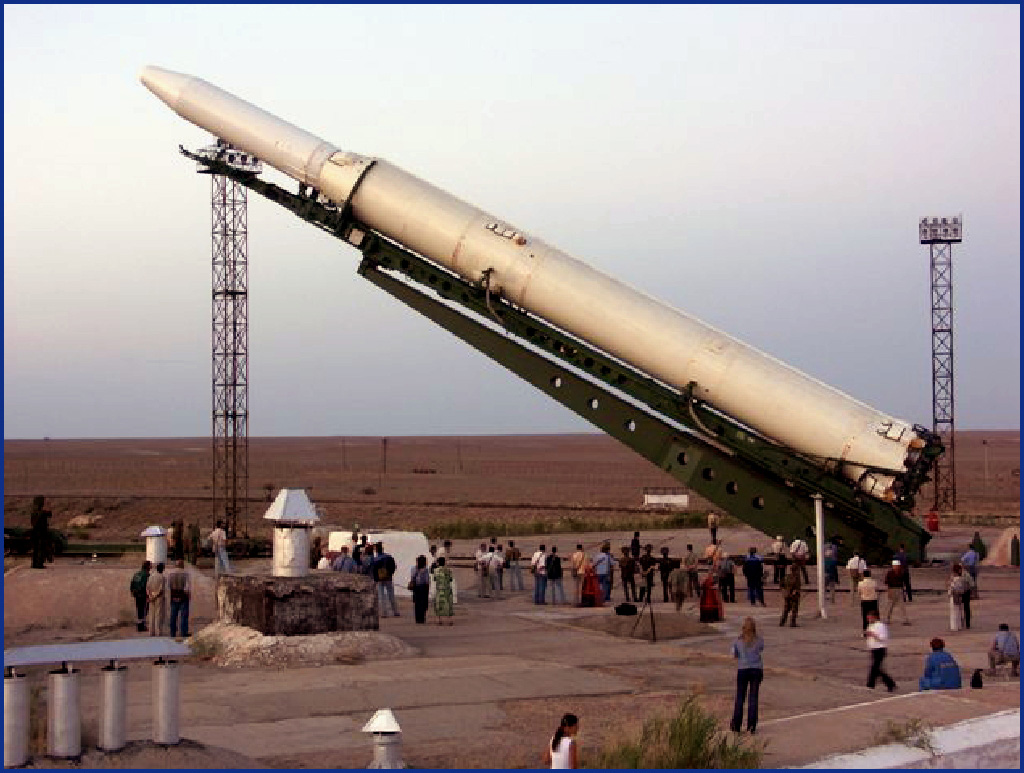
The level of automation for the cycle of pre-launch preparation and launch of a PH is 100%.
Heptyl detoxification:
The essence of the method of reducing the toxicity of UDMH is to feed 20% formalin solution into the fuel tanks of rockets:
(CH3) 2NNH2 + CH2O = (CH3) 2NN = CH2 + H2O + Q
This operation in excess of formalin leads to complete (100%) destruction of UDMH by conversion to dimethyl hydrazone formaldehyde in one treatment cycle in 1-5 seconds. This prevents the formation of dimethylnitrosamine (CH3) 2NN = O.
The next phase of the process is the destruction of dimethyl hydrazone formaldehyde (DMGF) by adding acetic acid to the tanks, causing dimerization of DMHF to glyoxal bis-dimethylhydrazone and the polymer mass. The reaction time is about 1 minute:
(CH3) 2NN = CH2 + H + → (CH3) 2NN = CHCH = NN (CH3) 2 + polymers + Q
The resulting mass is moderately toxic, well soluble in water.
It is time to wrap up, I will not restrain myself in the afterword, and again I will quote S. Lukyanenko:
" - And people call them cab drivers.
- Reptiloid pointed out a short leg to me. "
- Are you an astronaut, granddaughters? - asked grandma. More approving than questioning. My jacket was too characteristic.
We were always told about the great future. About the happiness of mankind. After all, I built communism ... then capitalism ... tried ... We all endured for this. For the sake of the future, for the sake of happiness ... Now you are building a stellar future. Boy, do you believe that this is not in vain?
Do these people believe in the stellar future of mankind? Do they need it, shook up by transportation problems and intermittent heat in the apartments, planned power outages and high cost of products? What gave them space - besides fear of other worlds and forced pride for the planet Earth, for its spaceships - the fastest in the galaxy ...
Primary Sources:
«Экологическая безопасность при испытаниях и отработке ракетных двигателей», А. Г. Галеев Учебное пособие, Издательство МАИ, 2006
Методология экспериментальной отработки ЖРД и ДУ, основы проведения испытаний и устройства испытательных стендов: монография [Электронный ресурс] /А.Г. Галеев, В.Н. Иванов, А.В. Катенин, В.А. Лисейкин, В.П. Пикалов, А.Д. Поляхов, Г.Г. Сайдов, А.А. Шибанов
«ПРОБЛЕМЫ ЭКОЛОГИЧЕСКОЙ ОПАСНОСТИ ПРИМЕНЕНИЯ ГЕПТИЛА – СВЕРХТОКСИЧНОГО РАКЕТНОГО ТОПЛИВА. ХРОНИКА СОБЫТИЙ» Пермское городское отделение Союза «За химическую безопасность» 2008 г.
Колесников, С.В. «Окисление несимметричного диметилгидразина (гептила)
и идентификация продуктов его превращения при проливах» Новосибирск: Изд. СибАК, 2014
Дилогия «Звёзды — холодные игрушки» С.В. Лукьяненко
Ракетное топливо как экологическая опасность, из государственного доклада 1995 г., Сообщение UCS-INFO.97, 17 декабря 1996 г.
geektimes.ru/post/243763 (Виталий Егоров@Zelenyikot)
Методология экспериментальной отработки ЖРД и ДУ, основы проведения испытаний и устройства испытательных стендов: монография [Электронный ресурс] /А.Г. Галеев, В.Н. Иванов, А.В. Катенин, В.А. Лисейкин, В.П. Пикалов, А.Д. Поляхов, Г.Г. Сайдов, А.А. Шибанов
«ПРОБЛЕМЫ ЭКОЛОГИЧЕСКОЙ ОПАСНОСТИ ПРИМЕНЕНИЯ ГЕПТИЛА – СВЕРХТОКСИЧНОГО РАКЕТНОГО ТОПЛИВА. ХРОНИКА СОБЫТИЙ» Пермское городское отделение Союза «За химическую безопасность» 2008 г.
Колесников, С.В. «Окисление несимметричного диметилгидразина (гептила)
и идентификация продуктов его превращения при проливах» Новосибирск: Изд. СибАК, 2014
Дилогия «Звёзды — холодные игрушки» С.В. Лукьяненко
Ракетное топливо как экологическая опасность, из государственного доклада 1995 г., Сообщение UCS-INFO.97, 17 декабря 1996 г.
geektimes.ru/post/243763 (Виталий Егоров@Zelenyikot)
Used data, photos and videos:
www.leninsk.ru
www.ekologia-ra.ru/osobye-vidy-vozdejstviya-na-okruzhayuschuyu-sredu/raketno-kosmicheskaya-deyatelnost
www.militaryrussia.ru
www.meganorm.ru
www.americaspace.com
www.novosti-kosmonavtiki.ru
www.spaceflightnow.com
www.sl-24.ru
www.npoenergomash.ru/encikloped/media
www.vakhnenko.livejournal.com/182895.html
www.youtu.be
www.epizodsspace.no-ip.org
www.i.ytimg.com
www.mil.ru
www.gamer.ru
www.ekologia-ra.ru/osobye-vidy-vozdejstviya-na-okruzhayuschuyu-sredu/raketno-kosmicheskaya-deyatelnost
www.militaryrussia.ru
www.meganorm.ru
www.americaspace.com
www.novosti-kosmonavtiki.ru
www.spaceflightnow.com
www.sl-24.ru
www.npoenergomash.ru/encikloped/media
www.vakhnenko.livejournal.com/182895.html
www.youtu.be
www.epizodsspace.no-ip.org
www.i.ytimg.com
www.mil.ru
www.gamer.ru
